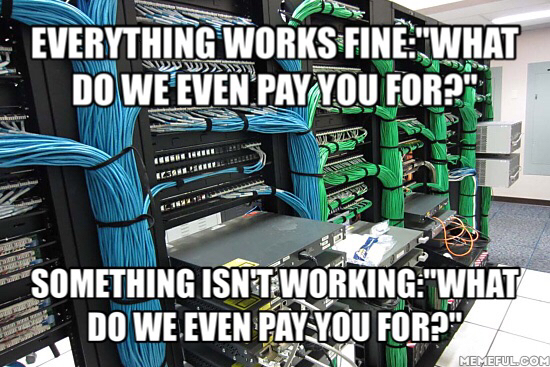How to Get Recognition and Elevate the Perception of IT in Your Workplace
May 24, 2016
4 minute read

If you work in IT, it’s possible that your non-IT colleagues don’t quite fully understand or appreciate what you do, and receiving recognition for your achievements is rare. This clip from HBO’s Silicon Valley encapsulates that sentiment:

As does this clip from The IT Crowd:

Indeed, IT departments are often viewed as cost centers that exist only to troubleshoot issues (“Mr. Fix Its”), and not as strategic assets to the business. IT can also be perceived as “invisible”—only noticed when something breaks, and even then, they’re under intense pressure to fix it ASAP.
Sound familiar?
Consider these findings from IDG Enterprise’s 2015 State of the Sysadmin Report:
- Although 95% of sysadmins feel passionate about their work, only 28% feel they get the recognition they deserve
- That lack of recognition is troublesome, given that 68% of sysadmins labeled their role as “extremely important” to their business, and 32% labeled it “very important”
- 76% of sysadmins feel that they’re important strategic assets, and yet…
- Only a measly 20% of non-IT staff views sysadmins as strategic
- 66% of non-IT staff view sysadmins as troubleshooters—people who are just there to fix problems and not do much else
- Only 30% of sysadmins say their IT peers think their role is strategic to their organization
IT professionals don’t need a pat on their heads every time they do something, but how can they get credit for their major achievements and gain more visibility in the workplace? How can IT get their colleagues to recognize them as enablers of change and assets that enable business strategy (and not as mere troubleshooters)?
We spoke to Miguel Jacq, who runs mig5, a sysadmin consultancy based in Melbourne, Australia. He shared some expert tips on how to elevate the perception of IT, get recognition for their strategic value, and demonstrate alignment with the business.
Publicize your successes
Do this even if you think people don’t care, says Jacq. “Make an announcement, or start a blog. Take your case study to a conference (with approval of course!) and talk about what you learned and how you did it.” CIO recommends a few tips for improving your self-promotion skills, including mastering the three-part accomplish statement and quantifying your worth. If you’re making a presentation or starting a blog, consider these tips for building an IT/tech blog and these tips for making technical presentations.
Show that IT isn’t just reactive—use technology to guide the business
Yes, IT is an “insurance policy” of sorts. “People pay for insurance for all sorts of protection in their life: whether it’s for their health, their home, their vehicle. Warranties and routine mechanic services work the same way: You might pay extra for it, but there’s an inherent appreciation or comfort taken from the knowledge that if something goes wrong, you paid for a protective measure to get out of that jam. IT is that measure,” he says.
But IT goes beyond being reactive. There is a unique strategic element involved. And IT can absolutely make improvements that go beyond just replacing parts and “changing the tires,” says Jacq.
“[IT] can use technology to steer a company in a specific direction. I have seen a company’s use of open source technology result in them becoming pioneers in the future and direction of that technology itself, and even result in the launch of a spin-off sister company just focusing on the open source product,” Jacq says.
Use metrics to your advantage
“Metrics speak for themselves and of your successes—be it continuous deployment statistics, amount of tickets closed vs. created, etc. Chart this stuff and put it on a big screen somewhere,” says Jacq.
Excite people with innovation
“If you have made improvements to something, or introduced something new, promote it. I did this when introducing IPv6 to an organization’s infrastructure when it was still very new,” says Jacq. “I knew that most people in the company didn’t know what IPv6 was, but this was an agency with a cultural identity of being ‘cutting edge’ and wanting to be seen to be trying new things. They understood this was one of those things. Enthusiasm rubs off on people.”
Improve your communication to combat the “cost center” stereotype
According to a survey report in CIO, four out of five IT leaders claim that building trust and credibility is highly important. But only a paltry four out of 100 believe they’re highly effective in communicating with their non-IT colleagues.
As such, effective communication is increasingly crucial for IT professionals, especially given the far-reaching impact it can have on the business. “Changing how you go about your work and communicate with others can impact a business beyond just troubleshooting and always being accused of ‘costing’ the business as a largely ‘unbillable’ department. Consider the ‘DevOps’ movement as an example of how interacting in new, collaborative ways can speed up the production pipeline and provide more opportunity for new business,” says Jacq.
Check out additional resources
If you’re interested in learning more on using communication to shift the perception of IT, Jacq recommends a few valuable resources:
- Tom Limoncelli’s Time Management for Sysadmins. “This short book covers communication and perception issues with IT departments,” he says. “Tom also gives good techniques for ‘deflecting’ noisy co-workers, how to say ‘no’ without appearing abrasive, and much more.”
- Lindsay Holmwood’s blog, Fractional. Jacq recommends these key articles, which center around effective communication: “Talk-to-Think, Think-to-Talk, and Leadership,” “Blame. Language. Sharing.”, and “Help! I’ve Just Been Made a Manager.”
For more information on effective communication, read our three-part series on how to communicate with non-IT minded people.







